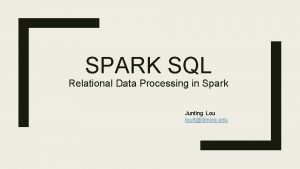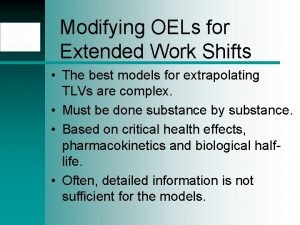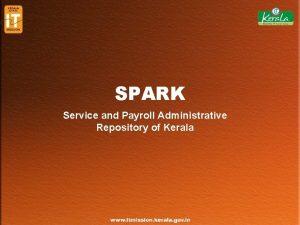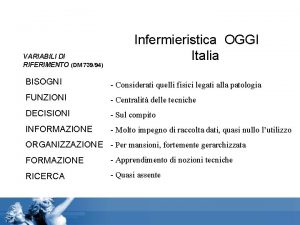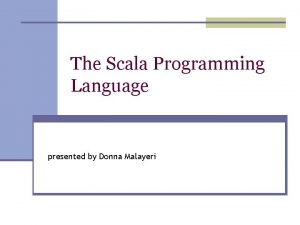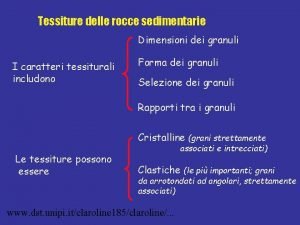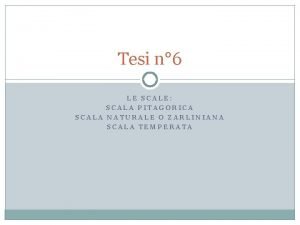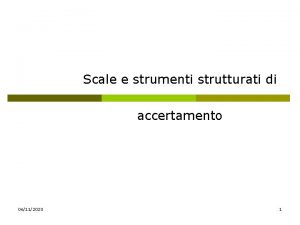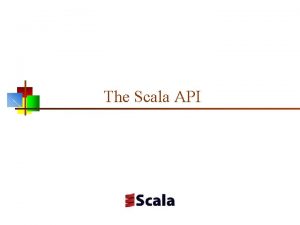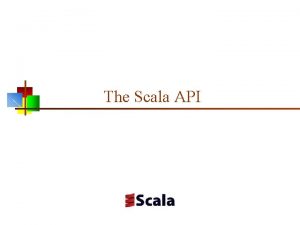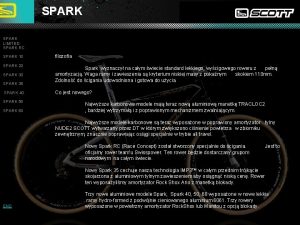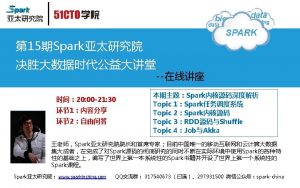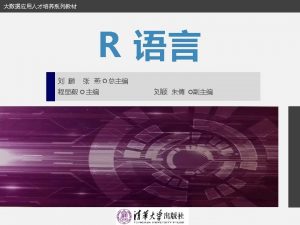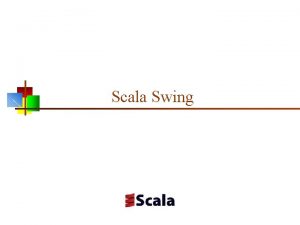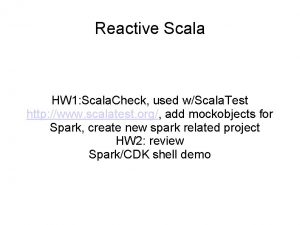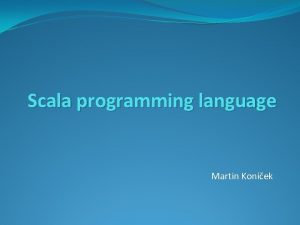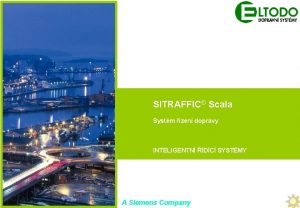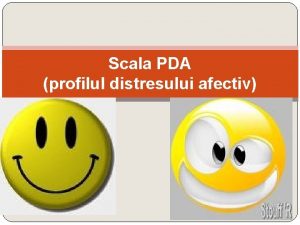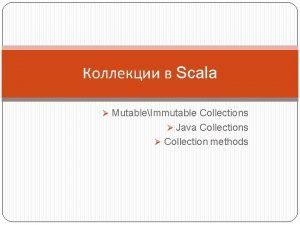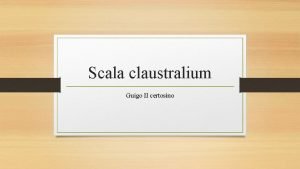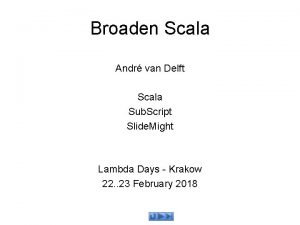Spark and Scala Spark What is it Why

























- Slides: 25

Spark and Scala

Spark - What is it? Why does it matter? ● Spark is a general-purpose distributed data processing engine that is suitable for use in a wide range of circumstances. On top of the Spark core data processing engine, there are libraries for SQL, machine learning, graph computation, and stream processing, which can be used together in an application. ● Programming languages supported by Spark include: Java, Python, Scala, and R. Application developers and data scientists incorporate Spark into their applications to rapidly query, analyze, and transform data at scale. ● Tasks most frequently associated with Spark include ETL and SQL batch jobs across large data sets, processing of streaming data from sensors, Io. T, or financial systems, and machine learning tasks.

Name a few programming languages supported by Spark?

Layers and Packages in Spark ● ● ● Spark SQL - Queries can be made on structured data using both SQL(Structured Query Language) and HQL (Hive Query Language). MLlib - designed to support multiple machine learning algorithms. It runs 100 times faster than Hadoop’s Map. Reduce. Spark Streaming - Spark allows Streaming for the creation of interactive applications that can perform data analysis operations on live streamed data. Graph. X - is an engine supported by Spark that allows the user to make computations using graphs.

What are the names of the layers and packages in Spark?

Downloading Spark And Installation ● ● Go to the Link: https: //spark. apache. org/downloads. html and click the download button. Spark requires Java to run and Spark is implemented using Scala. So make sure you have both installed on your computer. Spark Environment can be configured according to your preferences using Spark. Conf or Spark Shell tools. It can also be done while the Installation Wizard is installing Spark. You need to initialize a new Spark. Context using your preferred language (i. e. Python, Java, Scala, R). This will set up services and connects to an execution environment for Spark applications.

Simple Spark Application ● Spark application can be developed in three of the following supported languages: 1) Scala 2)Python 3)Java ● It provides two abstraction in its application: ■ RDD(Resilient Distributed Dataset) ■ Two types of shared variable in parallel Operation: ○ Broadcast variable ○ Accumulators ● 3 basic steps for completing an application: 1) Writing the Application 2) Compiling and packaging the Scala and Java Applications 3) Running the application

How a Spark Application Runs on a cluster? ● A Spark application runs as independent processes, coordinated by the Spark. Session object in the driver program. ● The resource or cluster manager assigns tasks to workers, one task per partition. ● A task applies its unit of work to the dataset in its partition and outputs a new partition dataset. Because iterative algorithms apply operations repeatedly to data, they benefit from caching datasets across iterations. ● Results are sent back to the driver application or can be saved to disk.

Simple Spark Application Continued ● After linking the spark library The next step is to create a Spark context object with the desired spark configuration that tells Apache Spark on how to access a cluster. ● “Word Count” – This is the name of the application that you want to run. ● “local”- This parameter denotes the master URL to connect the spark application to. ● /usr/local/spark- This parameter denotes the home directory of Apache Spark. ● Map() – The first map specifies the environment whilst the second one specifies the variables to work nodes. ● Creating a Spark RDD ● The next step in the Spark Word count example creates an input Spark RDD that reads the text file input. txt using the Spark Context created in the previous step● Spark RDD Transformations in Wordcount Example ● Spark application code transform the input RDD to count RDD ● In this piece of code, flat. Map () is used to tokenize the lines from input text file into words. ● Map () method counts the frequency of each word. ● reduce. By. Key () method counts the repetitions of word in the text file. ● Running Spark Application ● We will submit the word count example in Apache Spark using the Spark shell instead of running the word count program as a whole ● $ spark-shell

True or False: In order to run Spark, you don’t need Java.

Spark Abstraction ● Resilient Distributed Database (RDD) It is the fundamental abstraction in Apache Spark. It is the basic data structure. RDD in Apache Spark is an immutable collection of objects which computes on the different node of the cluster. ● ● ● Resilient- i. e. fault-tolerant , so able to recompute missing or damaged partitions due to node failures. Distributed - since Data resides on multiple nodes. Dataset -represents records of the data you work with. The user can load the data set externally which can be either JSON file, CSV file, text file or database via JDBC with no specific data structure.

Spark Abstraction ● Data Frame We can term Data. Frame as Dataset organized into columns. Data. Frames are similar to the table in a relational database or data frame in R /Python. ● Spark Streaming It is a Spark’s core extension, which allows Real-time stream processing from several sources. To offer a unified, continuous Data. Frame abstraction that can be used for interactive and batch queries these two sources work together. It offers scalable, high-throughput and fault-tolerant processing. ● Graph. X It is one more example of specialized data abstraction. It enables developers to analyze social networks. Also, other graphs alongside Excel-like two-dimensional data.

Which Spark Abstraction is known to be fault tolerant?

PYSPARK ● Py. Spark in an interactive shell for Spark in Python. ● Using Pyspark we can work with RDD’s in python programming language by using Pyj 4 library. ● Pyspark offers pyspark shell which links the Python API to the spark core and initializes the spark context. ● The Py. Spark supports Python 2. 6 and above. ● The Python shell can be used explore data interactively and is a simple way to learn the API

Example: from sc words pyspark = import Spark. Context("local", = sc. parallelize "spark "pyspark ) counts = print "Number of elements in RDD -> %i" % (counts) Output is : Number of elements in RDD → 8 "count vs and Spark. Context app") ( ["scala", "java", "hadoop", "spark", "akka", hadoop", "pyspark", spark"] words. count()

Question What are the languages supported by Apache Spark for developing big data applications?

Python API ● ● ● In Py. Spark, RDDs support the same methods as their Scala counterparts but take Python functions and return Python collection types. It is dynamically typed hence because of that RDDs can hold objects of multiple types. You can also pass functions that are defined with the def keyword; this is useful for longer functions that can’t be expressed using lambda.

Python API ● Functions can access objects in enclosing scopes, although modifications to those objects within RDD methods will not be propagated back: ● Py. Spark will automatically ship these functions to workers, along with any objects that they reference. Instances of classes will be serialized and shipped to workers by Py. Spark, but classes themselves cannot be automatically distributed to workers.

Question Do, we have machine learning API in Python? (True/False)

What is Scala? ● ● Scala is a general purpose language that can be used to develop solutions for any software problem. Scala combines object-oriented and functional programming in one concise, highlevel language. Scala's static types help avoid bugs in complex applications, and its JVM and Java. Script runtimes let you build high-performance systems with easy access to huge ecosystems of libraries. Scala offers a toolset to write scalable concurrent applications in a simple way with more confidence in their correctness. Scala is an excellent base of parallel, distributed, and concurrent computing, which is widely thought to be a very big challenge in software development but by the unique combination of features has won this challenge. Scala can also be termed as a machine compiled language.

Why Scala? ● ● ● Using Scala apps are less costlier to maintain and easier to evolve Scala because Scala is a functional and object-oriented programming language that makes light bend reactive and helps developers write code that's more concise than other options. Scala is used outside of its killer-app domain as well, of course, and certainly for a while there was a hype about the language that meant that even if the problem at hand could easily be solved in Java, Scala would still be the preference, as the language was seen as a future replacement for Java. It reduces the amount of code developers to write the code.

What is a drawback of Scala?

Example programs with Scala and Python Word. Count: In this example we use few transformations to build a dataset of (String, int) pairs called counts and save it to a file. Scala: Python: val text. File = sc. text. File("hdfs: //. . . ") val counts = text. File. flat. Map(line => line. split(" ")). map(word => (word, 1)). reduce. By. Key(_ + _) counts. save. As. Text. File("hdfs: //. . . ") text_file = sc. text. File("hdfs: //. . . ") # Read data from file counts = text_file. flat. Map(lambda line: line. split(" ")) . map(lambda word: (word, 1)) . reduce. By. Key(lambda a, b: a + b) counts. save. As. Text. File("hdfs: //. . . ") #Save output into the file

Prediction with Regressions utilizing MLlib Scala: // Read data into dataframe val df = sql. Context. create. Data. Frame(data). to. DF ("label", "features") Python: #Read data into dataframe df = sql. Context. create. Data. Frame(data, ["label", "features"]) val lr = new Logistic. Regression(). set. Max. Iter(10) lr = Logistic. Regression(max. Iter=10) val model = lr. fit(df) #Fit the model to the data val weights = model. weights model = lr. fit(df) // Predicting the results using the model. transform(df). show() # Predicting the results using the model. transform(df). show()

Questions?
 Scala tympani scala vestibuli
Scala tympani scala vestibuli Andreas carlsson bye bye bye
Andreas carlsson bye bye bye Scala vestibuli scala tympani birleştiği yer
Scala vestibuli scala tympani birleştiği yer Aditus ad antrum mastoideum
Aditus ad antrum mastoideum Sentiment analysis pyspark
Sentiment analysis pyspark Spark sql: relational data processing in spark
Spark sql: relational data processing in spark Dont ask why why why
Dont ask why why why Why do new ideas spark change
Why do new ideas spark change Brief and scala model
Brief and scala model Service and payroll repository
Service and payroll repository Why-why analysis
Why-why analysis Why do you cry willie why do you cry
Why do you cry willie why do you cry Does the table represent a function why or why not
Does the table represent a function why or why not What does a table represent
What does a table represent Why or why not
Why or why not Metode analisa masalah
Metode analisa masalah Scala asgo
Scala asgo Scala di cheops
Scala di cheops Legame metallico zanichelli
Legame metallico zanichelli Scala di valutazione tinetti
Scala di valutazione tinetti Donna malayeri
Donna malayeri Echippus
Echippus Scala di wentworth
Scala di wentworth Sitraffic stella
Sitraffic stella Scala thurstone
Scala thurstone Gosnell scala
Gosnell scala





